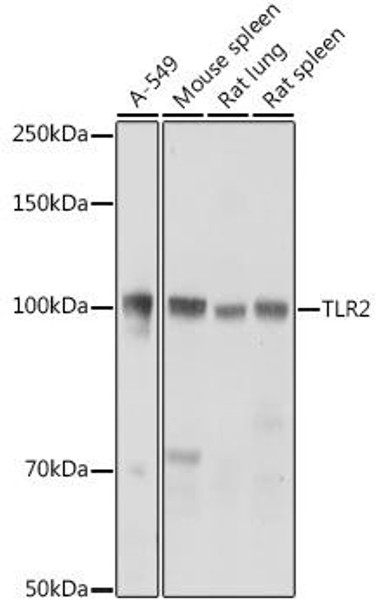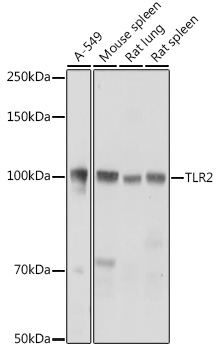Anti-TLR2 Antibody (CAB2545)
- SKU:
- CAB2545
- Product type:
- Antibody
- Reactivity:
- Human
- Reactivity:
- Mouse
- Reactivity:
- Rat
- Host Species:
- Rabbit
- Isotype:
- IgG
- Research Area:
- Immunology
Description
| 抗体名: | Anti-TLR2 Antibody |
| 抗体コード: | CAB2545 |
| 抗体サイズ: | 20uL, 50uL, 100uL |
| 申し込み: | WB IF |
| 反応性: | Human, Mouse, Rat |
| 宿主種: | Rabbit |
| 免疫原: | Recombinant fusion protein containing a sequence corresponding to amino acids 19-300 of human TLR2 (NP_003255.2). |
| 申し込み: | WB IF |
| 推奨希釈: | WB 1:500 - 1:2000 IF 1:50 - 1:200 |
| 反応性: | Human, Mouse, Rat |
| ポジティブサンプル: | A-549, Mouse spleen, Rat lung, Rat spleen |
| 免疫原: | Recombinant fusion protein containing a sequence corresponding to amino acids 19-300 of human TLR2 (NP_003255.2). |
| 精製方法: | Affinity purification |
| ストレージバッファ: | Store at -20'C. Avoid freeze / thaw cycles. Buffer: PBS with 0.02% sodium azide, 50% glycerol, pH7.3. |
| アイソタイプ: | IgG |
| 順序: | KEES SNQA SLSC DRNG ICKG SSGS LNSI PSGL TEAV KSLD LSNN RITY ISNS DLQR CVNL QALV LTSN GINT IEED SFSS LGSL EHLD LSYN YLSN LSSS WFKP LSSL TFLN LLGN PYKT LGET SLFS HLTK LQIL RVGN MDTF TKIQ RKDF AGLT FLEE LEID ASDL QSYE PKSL KSIQ NVSH LILH MKQH ILLL EIFV DVTS SVEC LELR DTDL DTFH FSEL STGE TNSL IKKF TFRN VKIT DESL FQVM KLLN QISG LLEL EFDD CTLN GVGN FRAS DN |
| 遺伝子ID: | 7097 |
| Uniprot: | O60603 |
| セルラーロケーション: | Membrane, Single-pass type I membrane protein |
| 計算された分子量: | 89kDa |
| 観察された分子量: | 105kDa |
| 同義語: | CD282, TIL4, TLR2 |
| バックグラウンド: | The protein encoded by this gene is a member of the Toll-like receptor (TLR) family which plays a fundamental role in pathogen recognition and activation of innate immunity. TLRs are highly conserved from Drosophila to humans and share structural and functional similarities. This protein is a cell-surface protein that can form heterodimers with other TLR family members to recognize conserved molecules derived from microorganisms known as pathogen-associated molecular patterns (PAMPs). Activation of TLRs by PAMPs leads to an up-regulation of signaling pathways to modulate the host's inflammatory response. This gene is also thought to promote apoptosis in response to bacterial lipoproteins. This gene has been implicated in the pathogenesis of several autoimmune diseases. Alternative splicing results in multiple transcript variants. |
| UniProt Protein Function: | TLR2: Cooperates with LY96 to mediate the innate immune response to bacterial lipoproteins and other microbial cell wall components. Cooperates with TLR1 to mediate the innate immune response to bacterial lipoproteins or lipopeptides. Acts via MYD88 and TRAF6, leading to NF-kappa-B activation, cytokine secretion and the inflammatory response. May also promote apoptosis in response to lipoproteins. Recognizes mycoplasmal macrophage- activating lipopeptide-2kD (MALP-2), soluble tuberculosis factor (STF), phenol-soluble modulin (PSM) and B.burgdorferi outer surface protein A lipoprotein (OspA-L) cooperatively with TLR6. Interacts with LY96, TLR1 and TLR6 (via extracellular domain). Binds MYD88 (via TIR domain). Interacts with TICAM1. Ligand binding induces the formation of a heterodimer with TLR1. Interacts with CNPY3. Highly expressed in peripheral blood leukocytes, in particular in monocytes, in bone marrow, lymph node and in spleen. Also detected in lung and in fetal liver. Levels are low in other tissues. Belongs to the Toll-like receptor family. |
| UniProt Protein Details: | Protein type:Membrane protein, integral; Apoptosis; Motility/polarity/chemotaxis; Cell surface; Receptor, misc. Chromosomal Location of Human Ortholog: 4q32 Cellular Component: cell surface; cell projection; integral to plasma membrane; cytoplasm; plasma membrane; external side of plasma membrane Molecular Function:peptidoglycan binding; protein binding; transmembrane receptor activity; triacylated lipoprotein binding; protein heterodimerization activity; lipopolysaccharide receptor activity; receptor activity; pattern recognition receptor activity; diacylated lipoprotein binding Biological Process: positive regulation of nitric oxide biosynthetic process; apoptosis; positive regulation of interleukin-12 production; response to toxin; positive regulation of leukocyte migration; microglial cell activation; leukotriene metabolic process; positive regulation of NF-kappaB import into nucleus; response to molecule of fungal origin; detection of triacylated bacterial lipoprotein; positive regulation of interleukin-18 production; signal transduction; nitric oxide metabolic process; positive regulation of interleukin-10 production; response to insulin stimulus; activation of NF-kappaB transcription factor; positive regulation of interleukin-8 production; negative regulation of cell proliferation; lipopolysaccharide-mediated signaling pathway; positive regulation of interferon-beta production; positive regulation of oligodendrocyte differentiation; inflammatory response; toll-like receptor 4 signaling pathway; positive regulation of Wnt receptor signaling pathway; positive regulation of tumor necrosis factor biosynthetic process; negative regulation of interleukin-12 production; detection of diacylated bacterial lipoprotein; cell surface pattern recognition receptor signaling pathway; positive regulation of interleukin-6 production; positive regulation of tumor necrosis factor production; positive regulation of toll-like receptor signaling pathway; positive regulation of chemokine production; toll-like receptor 2 signaling pathway; MyD88-dependent toll-like receptor signaling pathway; induction by symbiont of defense-related host nitric oxide production; defense response to Gram-positive bacterium; negative regulation of interleukin-17 production; myelin formation in the central nervous system; response to hypoxia; toll-like receptor signaling pathway; innate immune response; positive regulation of transcription from RNA polymerase II promoter; immune response; response to progesterone stimulus; I-kappaB phosphorylation; chloramphenicol transport; positive regulation of cytokine secretion; positive regulation of nitric-oxide synthase biosynthetic process; positive regulation of inflammatory response Disease: Leprosy, Susceptibility To, 3; Mycobacterium Tuberculosis, Susceptibility To |
| NCBI Summary: | The protein encoded by this gene is a member of the Toll-like receptor (TLR) family which plays a fundamental role in pathogen recognition and activation of innate immunity. TLRs are highly conserved from Drosophila to humans and share structural and functional similarities. They recognize pathogen-associated molecular patterns (PAMPs) that are expressed on infectious agents, and mediate the production of cytokines necessary for the development of effective immunity. The various TLRs exhibit different patterns of expression. This gene is expressed most abundantly in peripheral blood leukocytes, and mediates host response to Gram-positive bacteria and yeast via stimulation of NF-kappaB. [provided by RefSeq, Jul 2008] |
| UniProt Code: | O60603 |
| NCBI GenInfo Identifier: | 20140434 |
| NCBI Gene ID: | 7097 |
| NCBI Accession: | O60603.1 |
| UniProt Secondary Accession: | O60603,O15454, Q8NI00, B3Y612, D1CS45, D1CS48, D1CS49 |
| UniProt Related Accession: | O60603 |
| Molecular Weight: | 89,838 Da |
| NCBI Full Name: | Toll-like receptor 2 |
| NCBI Synonym Full Names: | toll-like receptor 2 |
| NCBI Official Symbol: | TLR2 |
| NCBI Official Synonym Symbols: | TIL4; CD282 |
| NCBI Protein Information: | toll-like receptor 2 |
| UniProt Protein Name: | Toll-like receptor 2 |
| UniProt Synonym Protein Names: | Toll/interleukin-1 receptor-like protein 4; CD_antigen: CD282 |
| Protein Family: | Toll-like receptor |
| UniProt Gene Name: | TLR2 |
| UniProt Entry Name: | TLR2_HUMAN |


